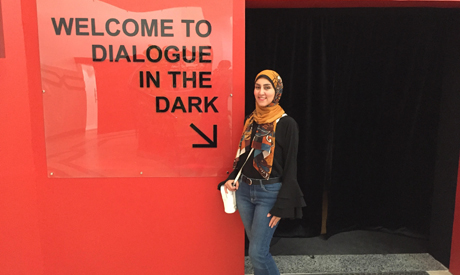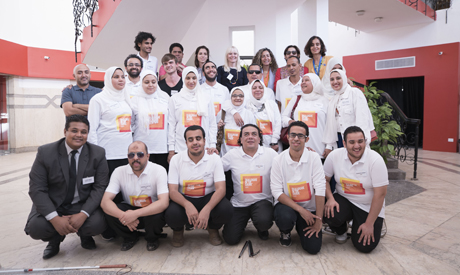Your guide in the darkness will be who you guide in the light. That is one of the lessons of the one-of-a-kind Dialogue in the Dark exhibition that opens in Cairo on 26 October.
If you haven’t ever challenged yourself to live in the dark by closing your eyes for an hour or more, the Dialogue in the Dark exhibition is for you, allowing you to enjoy an hour of exploration in total darkness in which you use the senses of smell, touch, hearing and taste to get a sense of place. With the help of a white stick, your senses and a guide, you get the chance to explore the unseen and learn to see in the darkness through the exchange of roles.
Dialogue in the Dark is an exhibition that aims to raise awareness about visual impairment. It was established more than 27 years ago in more than 41 countries throughout the world, and now it is coming to Egypt. Egypt has the highest percentage of blind people in the Arab world, and the exhibition is a capacity-building activity where workers and visitors alike can enhance their communication skills and trust. The team works on how to make the experience even more engaging and impactful, encouraging visitors to leave their comfort zones.

Omneya Yousry
When I entered the exhibition in a preview, I found that visitors are guided by visually impaired or blind guides in absolute darkness. This offered me the chance to explore daily environments through the other senses. Daily routines become exciting and a reversal of roles is created where the sighted become blind and the blind become sighted. I was surprised at how scared of the dark I was, but then after 30 minutes my mind become used to the fact that I was dependent on someone who couldn’t see either.
He was not only my guide, but also my protector. “I’m with you. Don’t be afraid. Just follow me,” he said. It was at that moment that I realised that he was not disabled at all but was simply asserting his right to be in an equal environment in everyday life as me. I was astonished at how dependent I was on my sight, while neglecting my other senses.
“Dialogue in the Dark for me is the dream of everyone who works in human development. The fact of having a strong business model changes the situation from feeling sympathy to having empathy. You are put in a similar context as those you attribute a disability to, and you have the chance to fully understand what they are going through, whether you feel it as a challenge or as part of normal life by the end,” commented Menna Ashraf, the exhibition’s marketing and communications manager.
“The exhibition is a social enterprise, and it includes Dialogue in the Dark, Dialogue in Silence and Dialogue in Time. The goal is to facilitate social inclusion and to raise awareness about people with disabilities, as well as disadvantaged and elderly people. The idea is to make people more aware of their needs, their potential and their contributions to society in order to foster empathy and respect. The exhibition can help change present-day prejudices and eradicate stigma,” she said.
The unusual aspect of Dialogue in the Dark is that it uses entertainment solutions to raise awareness about its cause instead of channels such as seminars, campaigns or fundraising. Members of the public are encouraged to take part in a fun experience. “People are not invited to support people with visual impairments. We need to help people go through this experience, change their stereotypes and find out about the importance of the other senses,” Ashraf said.

A dialogue in the dark team
EMERGING FROM THE DARK: As I went through the exhibition, an invisible landscape seemed to emerge composed of sounds, scents and textures.
It stimulated real places in Cairo where I had to guess where I was, and the whole had taken three years to produce. I explored a park, a square, a neighbourhood and enjoyed a cup of tea in a café. The experience allowed me to have fun and to discover how to orientate myself and move in the dark, how to identify the world through the remaining senses, how to generate trust and how to cope with the unknown. I felt calm and didn’t want it to finish.
The concept of Dialogue in the Dark was founded in Germany by Andreas Heinecke in 1988. After studies in philosophy, he started working at a radio station where he was asked to develop training for a young journalist who had lost his eyesight through a tragic accident. The encounter with the blind journalist changed his life, and Heinecke began to understand that being blind contained a potential he had never thought about, even as prejudice about blindness is still unfortunately widespread, and blind or visually impaired people may not have equal access to education or the labour market.
Heinecke decided to turn off the lights, darken a room and invite blind and sighted people to meet under reverse conditions. He started to experiment and opened the first Dialogue in the Dark exhibition in Germany in 1989.
It was then that he became a social entrepreneur. The idea grew steadily, and new formats like Dinner in the Dark were created in 1993. Business workshops in the dark were added in 1994. Today, Dialogue in the Dark is an international network, and more than nine million visitors have gone through an experience in the dark and thousands of blind and visually impaired guides and facilitators have found employment through exhibitions and workshops. Internationally acclaimed, Dialogue in the Dark is one of the best-known social business concepts worldwide.
In many cases, the exhibition guides had been working in other positions before they joined the exhibition, feeling that it had a mission and hoping to help raise awareness about inclusion and diversity. In other cases, the guides had not worked before or even had the opportunity to complete their education. For them, it has been about a journey from being the passive receiver of care and services to an active contributor to society.
Potential exhibition guides undergo a strict selection process. “The guides are trained by senior guides from Germany and Mexico who have come to Egypt to do so. It’s very inspiring to see some of them getting promoted and having the chance to travel around the world on work missions. On the other hand, we also conduct some local training related to the Egyptian context, as well as some social-skills training on how to deal with stressed visitors or how to interact with the public and deal with emergency cases. We also provide the opportunity for those who exceed expectations to work in other fields,” Ashraf said.
I met Hosna Saleh, 27, who works as a guide at the exhibition. “I was born partially blind and faced various challenges during my daily life and study, but this didn’t hinder me from finishing a BA in English, a postgraduate diploma, a general diploma in education and a professional diploma in special education,” Saleh said.
“I heard about Dialogue in the Dark from some friends and was excited to get more information from the Internet. I didn’t say no to an opportunity where I would be able to explain how the blind live on a daily basis through a simulation that works better than any awareness seminars. It benefits society and teaches people how to deal with the visually impaired rather than looking at us as sick or infirm,” she added.
Guide Islam Saber said “I had started my journey with darkness when I was 11 years old as a result of an accident. I had only one path to take, which was to cope with it as best I could. I got a bachelor’s degree in 1999, and eventually I became a board member of the Association for the Welfare of the Blind in Ismailia and a consultant at the Ministry of Communication. When I got accepted at Dialogue in the Dark, I felt that this was somewhere where I could have a clear effect,” he added.
Undoubtedly, every visitor has a lot to learn through Dialogue in the Dark.
*A version of this article appears in print in the 17 October, 2019 edition of Al-Ahram Weekly.
Short link: